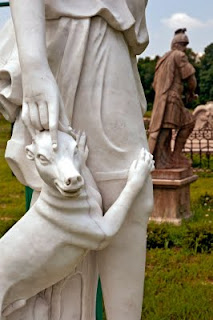Charlie’s Antiques 02, 2011
Someone asked me the other day whether I’d won any photo competitions lately. The answer was “No,” mainly because I haven’t entered any lately.
What I can say with some confidence, though, is that at least for the last several days I’m bound to have won the contest of how many different blog posts I could harvest from one two-hour drive.
The last few days’ posts have all been about things that happened on a single drive. Most of the pictures were taken within the same hour at different places along just one 30-mile stretch of highway between Williamsburg and Richmond, Virginia. This is the last of these posts, but I hope you’ll agree that I saved the best for the last.
So I was driving up Route 60 from Williamsburg toward Richmond. I’d gone though the little hamlets of Norge and was almost to Toano when I happened to see a something out of the corner of my eye that seemed completely out of context.

Charlie’s Antiques 15, 2011
Off to my left, scattered across an uncultivated field, was an array of what I’m calling “estate statuary.” It looked like someone had been present at the demolition of a grand British country estate and filled a container with all of the statues, benches and other man-made landscape elements.
Of course, I had to stop and see what this was all about. One doesn’t associate such stuff with eastern Virginia. But it has to come from somewhere, I suppose. So I made a U-turn and pulled the car over into the field.
I wandered around for about fifteen minutes, looking at he statues and shaking crickets and other bugs off my pants legs. Nestled up against a bush was a stone lion. Not far away and surrounded by an ancient wrought iron railing was the framework for a glass conservatory. Statues of dogs and naked women and naked women with dogs were scattered around, all without any apparent explanation.
I took my pictures and left. A little further down the highway I found the explanation I’d been looking for. It was in Toano and is an antiques business called Charlie’s. The web site doesn’t do justice to the crowded lot of bronze birds, stone Chinese soldiers, Italian fountains and other landscape statues scattered around the Charlie’s Antiques barn. For that you’ll have to go there yourself.

Charlie’s Antiques 17, 2011

Charlie’s Antiques 22, 2011


























